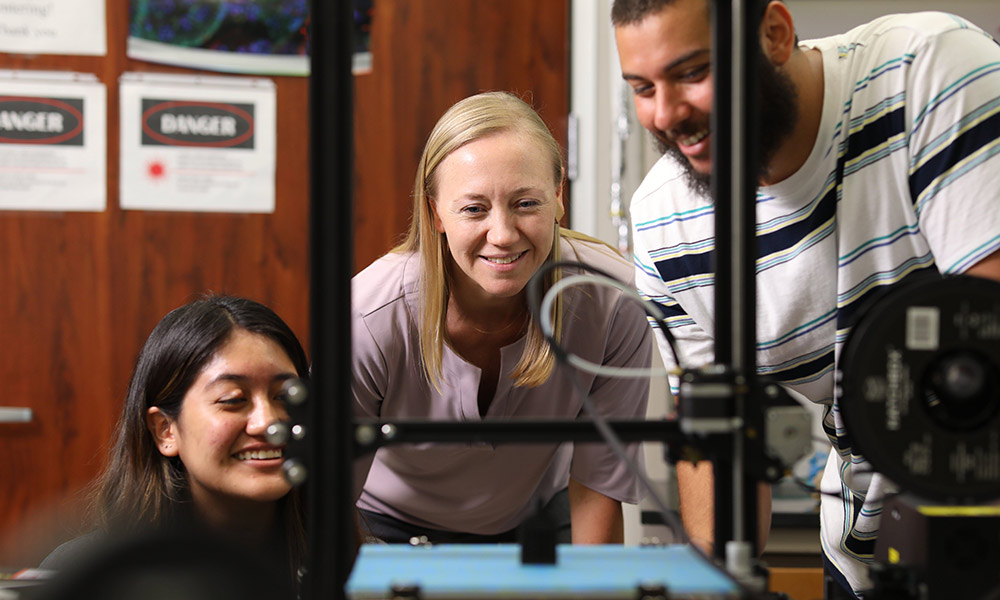
If anyone has had their optics-focused career marked by ongoing engagement with SPIE, it’s Kristen Maitland.
As an electrical engineering undergraduate at California Polytechnic State University at San Luis Obispo, Maitland became an SPIE Student Member when a professor encouraged her to join the Society. “I was a Student Member on the Membership & Communities Committee which connected me early on to SPIE leadership and staff,” she says. “All of these academics and industry professionals were so wonderful and welcoming, helping me build a career-focused network from that early stage.” She applied for SPIE scholarships, becoming a recipient in 2003, 2004, and 2005. Those awards didn’t just help cover her education, they provided a less visible boost: “It felt like an honor to be selected for these recognitions,” notes Maitland. “It felt like a vote of confidence in my professional capability.”
The support she received from SPIE proved inspirational. Maitland founded an SPIE Student Chapter at the University of Texas, Austin, where she attended graduate school for biomedical engineering; she was also a faculty sponsor to the SPIE Student Chapter at Texas A&M University, where she worked from 2008 to 2022 as an associate professor of biomedical engineering and director of the university’s Microscopy and Imaging Center. “I really felt like SPIE chapters were a great opportunity for students to connect around their academic interests,” says Maitland. “I’d had such positive experiences with student chapters myself, and, by then, I was an advocate for SPIE.”
Maitland, now a senior program manager in imaging with the Chan Zuckerberg Initiative, has been an SPIE Fellow since 2018. She sat on the SPIE Board of Directors from 2017 to 2020, and has contributed to the Society’s Engagement, Scholarship, Symposia, Education & Outreach, Strategic Planning, Nominating & Leadership Development, and Conference Program committees, among other SPIE-related activities.
“SPIE really stands out with its conferences,” says Maitland. “They are top-notch, offering amazing experiences and opportunities for attendees to learn about what's going on in the field and to make professional, in-person connections.” (In a career-trajectory move demonstrating one of the pinnacles of networking successes, Maitland, together with her husband, was originally recruited to Texas A&M at an SPIE conference). Another thing SPIE does well, she says, is connecting academic research with industry and developing technologies: “It's great for students in particular because they can come in with that academic-research focus, and, through SPIE, they get exposed to opportunities in industry and are able to pursue those opportunities. SPIE is great at helping them transition from a student into an industry professional.”
Her appreciation for that level of networking and connectivity that SPIE facilitates grew partly from Maitland’s experience 20 years ago at the Ven Biophotonics Graduate Summer School, a program which this year was run by SPIE.
“That program is so focused on the students, starting off their careers, interacting with leaders in the field,” she says. “There are technical presentations, but the greatest benefit is the social interactions. Those really helped me in terms of my career, because I grew professionally with this innate network of colleagues who knew me from my student years. They looked out for me and advocated for me.” That kind of networking opportunity, she says, is key: “It’s not just about presenting your research, but about the personal connections you make. As a doctoral student, I would spend my own money to attend SPIE conferences, because I understood that interacting with others was critical to growing my career.”
That career has always focused on biomedical optics. At Texas A&M, Maitland developed light-based technologies for biomedical applications, building optical-imaging systems whose applications included early cancer detection, tuberculosis detection, and cell-culture monitoring. “I love working on lots of different things,” Maitland explains. “Whenever a new researcher said, ‘I wish I could do this,’ I would say, ‘Well, I think we can build something for that!’” That breadth of interest generated a diversity of skills among Maitland’s students in her lab: “They grew as systems engineers, with computational abilities as well as knowledge of tool development and instrumentation, imaging a variety of human and animal cells. It was a lot of fun.”
When the Chan Zuckerberg Initiative (CZI) opportunity arose, Maitland decided to pursue her love of biomedical optics in a role that allows her to support the imaging community more broadly. “CZI’s mission is to support the science and technology that would enable us to cure, prevent, and manage disease by the end of this century,” explains Maitland. “One thing we do, by supporting interdisciplinary collaborations on a global level, is develop novel imaging technologies that can map, measure, and model complex biological systems. I help define that strategy and fund imaging-systems research. For me, it’s a refreshing new view on science, and I'm learning a lot.”
It’s a level of enjoyable professional learning that, Maitland maintains, got its early start with SPIE. “SPIE does so much, from funding students and international outreach programs to connecting like-minded optics professionals across the globe,” says Maitland. “It’s been a wonderful part of my career development.”